

Accelerate Telecom Cloud Deployments with Dell Telecom Infrastructure Blocks
Mon, 31 Oct 2022 16:48:10 -0000
|Read Time: 0 minutes
During MWC Vegas, Dell Technologies announced Dell’s first Telecom Infrastructure Blocks co-engineered with our partner Wind River to help communication service providers (CSPs) reduce complexity, accelerate network deployments, and simplify life cycle management of 5G network infrastructure. Their first use cases will be focused on infrastructure for virtual Radio Access Network (vRAN) and Open RAN workloads.
Deploying and supporting open, virtualized, and cloud-native 5G RANs is one of the key requirements to accelerate 5G adoption. The number of options available in 5G RAN design makes it imperative that infrastructures supporting them are flexible, fully automated for distributed operations, and maximally efficient in terms of power, cost, the resources they consume, and the performance they deliver.
Dell Telecom Infrastructure Blocks for Wind River are designed and fully engineered to provide a turnkey experience with fully integrated hardware and software stacks from Dell and Wind River that are RAN workload-ready and aligned with workload requirements. This means the engineered system, once delivered, will be ready for RAN network functions onboarding through a simple and standard workflow avoiding any integration and lifecycle management complexities normally expected from a fully disaggregated network deployment.
The Dell Telecom Infrastructure Blocks for Wind River are a part of the Dell Technologies Multi-Cloud Foundation, a telecom cloud designed specifically to assist CSPs in providing network services on a large scale by lowering the cost, time, complexity, and risk of deploying and maintaining a distributed telco-cloud. Dell Telecom Infrastructure Blocks for Wind River are comprised of:
- Dell hardware that has been validated and optimized for RAN
- Dell Bare Metal Orchestrator and a Bare Metal Orchestrator Module (a combination of a Bare Metal Orchestrator plug-in and a Wind River Conductor integration plug-in)
- Wind River Studio, which is comprised of:
- Wind River Conductor
- Wind River Cloud Platform
- Wind River Analytics
How do Dell Telecom Infrastructure Blocks for Wind River make infrastructure design, delivery, and lifecycle management of a telecom cloud better and easier?
From technology onboarding to Day 2+ operations for CSPs, Dell Telecom Infrastructure Blocks streamline the processes for technology acquisition, design, and management. We have broken down these processes into 4 stages. Let us examine how Dell Telecom Infrastructure Blocks for Wind River can impact each stage of this journey.
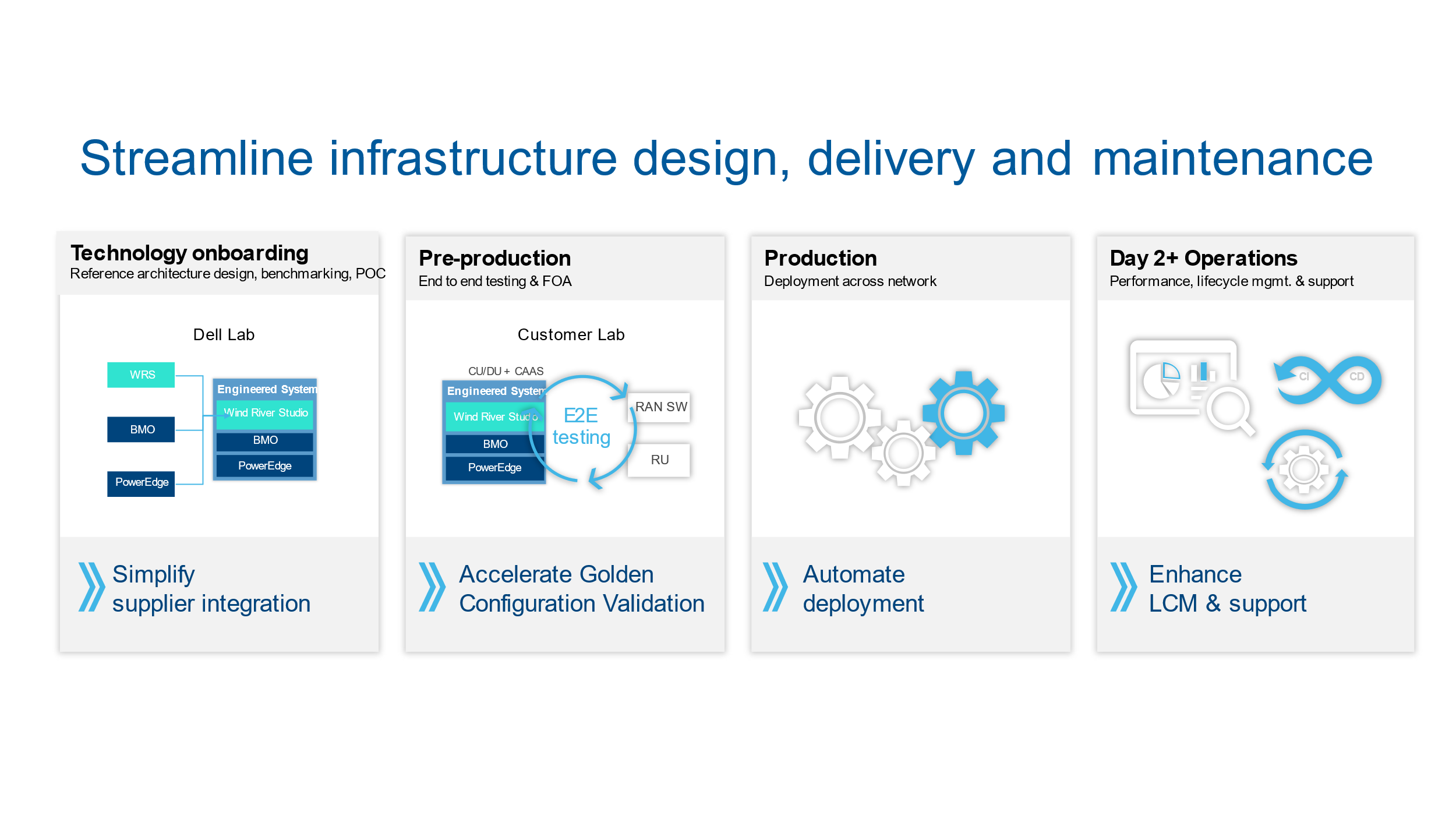
Stage 1: Technology onboarding | Faster Time to Market
The first stage is the Technology onboarding, where Dell Technologies works with Wind River in Dell’s Solution Engineering Lab to develop the engineered system. Together we design, validate, build, and run a broad range of test cases to create an optimized engineered system for 5G RAN vCU/vDU and Telecom Multi-Cloud Foundation Management clusters. During this stage, we conduct extensive solution testing with Wind River performing more than 650 test cases. This includes validating functionality, interoperability, security, scalability, high availability, and test cases specific to the workload’s infrastructure requirements to ensure this system operates flawlessly across a range of scale and performance points.
We also launched our OTEL Lab (Open Telecom Ecosystem Lab) to allow telecom ecosystem suppliers (ISVs) to integrate or certify their workload applications on Dell infrastructure including Telecom Infrastructure Blocks. Customers and partners working in OTEL can fine-tune the Infrastructure Block to a given CSP’s needs, marrying the efficiency of Infrastructure Block development with the nuances presented in meeting a CSP’s specific requirements.
Continuous improvement in the design of Infrastructure Blocks is enabled by ongoing feedback on the process throughout the life of the solution which can further streamline the design, validation, and certification. This extensive process produces an engineered system that streamlines the operator’s reference architecture design, benchmarking, proof of concept, and end-to-end validation processes to reduce engineering costs and accelerate the onboarding of new technology.
All hardware and software required for this Engineered system are integrated in Dell’s factory and sold and supported as a single system to simplify procurement, reduce configuration time, and streamline product support.
This "shift left" in the design, development, validation, and integration of the stacks means readiness testing and integration are finished sooner in the development cycle than they would have been with more traditional and segregated development and test processes. For CSPs, this method speeds up time to value by reducing the time needed to prepare and validate a new solution for deployment.
Now we go from Technology onboarding to the second phase, pre-production.
Stage 2: Pre-production | Accelerated onboarding
From Dell’s Solution Engineering Labs, the engineered system moves into the CSPs pre-production environment where the golden configuration is defined. Rather than receiving a collection of disaggregated components, (infrastructure, cloud stacks, automation, and so on.) CSPs start with a factory-integrated, engineered system that can be quickly deployed in their pre-production test lab. At this stage, customers leverage the best practices, design guidance, and lessons learned to create a fully validated stack for their workload. The next step is to pre-stage the Telco Cloud stack including the workload and start preparing for Day 1 and Day 2 by integrating with the customer CI/CD pipeline and defining/agreeing on the life-cycle management process to support the first office application deployment.
Stage 3: Production | Automation enables faster deployment
Advancing the flow, deployment into production is accelerated by:
- Factory integration that reduces procurement, installation, and integration time on-site.
- Embedded automation that reduces time spent configuring hardware or software. This includes validating configurations and streamlining processes with Customer Information Questionnaires (CIQs). CIQs are YAML files that list credentials, management networks, storage details, physical locations, and other relevant data needed to set the telco cloud stack at different physical locations for CSPs.
- Streamlining support with a unified single call carrier-grade support model for the full cloud stack.
Automating deployment eliminates manual configuration errors to accelerate product delivery. Should the CSP need assistance with deployment, Dell's professional services team is standing by to assist. Dell provides on-site services to rack, stack, and integrate servers into their network.
Stage 4: Day 2+ Operations | Performance, lifecycle management, and support
Day 2+ operations are simplified in several ways. First, the automation provided, combined with the extensive validation testing Dell and Wind River perform, ensure a consistent, telco-grade deployment, or upgrade each time. This streamlines daily fault, configuration, performance, and security management in the fully distributed cloud. In addition, Dell Bare Metal Orchestrator will automate the detection of configuration drift and its remediation. And, Wind River Studio Analytics utilizes machine learning to proactively detect issues before they become a problem.
Second, Dell’s Solutions Engineering lab validates all-new feature enhancements to the software and hardware including new updates, upgrades, bug fixes, and security patches. Once we have updated the engineered system, we push it via Dell CI/CD pipeline to Dell factory and OTEL Lab. We can also push the update to the CSP's CI/CD pipeline using integrations set up by Dell Services to reduce the testing our customers perform in their labs.
We complement all this by providing unified, single-call support for the entire cloud stack with options for carrier-grade SLAs for service response and restoration times.
Proprietary appliance-based networks are being replaced by best-of-breed, multivendor cloud networks as CSPs adapt their network designs for 5G RAN. As CSPs adopt disaggregated, cloud-native architectures, Dell Technologies is ready to lend a helping hand. With Dell Telecom Multi-Cloud Foundation, we provide an automated, validated, and continuously integrated foundation for deploying and managing disaggregated, cloud-native telecom networks.
Ready to talk? Request a callback.
To learn more about our solution, please visit the Dell Telecom Multi-Cloud Foundation solutions site
Authored by:
Gaurav Gangwal
Senior Principal Engineer – Technical Marketing, Product Management
About the author:
Gaurav Gangwal works in Dell's Telecom Systems Business (TSB) as a Technical Marketing Engineer on the Product Management team. He is currently focused on 5G products and solutions for RAN, Edge, and Core. Prior to joining Dell in July 2022, he worked for AT&T for over ten years and previously with Viavi, Alcatel-Lucent, and Nokia. Gaurav has an engineering degree in electronics and telecommunications and has worked in the telecommunications industry for about 14 years. He currently resides in Bangalore, India.

Related Blog Posts
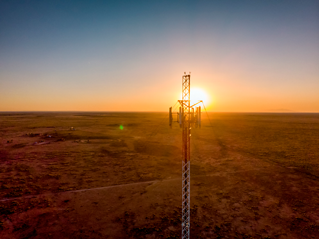
How Dell Telecom Infrastructure Blocks are Simplifying 5G RAN Cloud Transformation
Thu, 08 Dec 2022 20:01:48 -0000
|Read Time: 0 minutes
5G is a technology that is transforming industry, society, and how we communicate and live in ways we’ve yet to imagine. Communication Service Providers (CSPs) are at the heart of this technological transformation. Although 5G builds on existing 4G infrastructure, 5G networks deployed at scale will require a complete redesign of communication infrastructure. 5G network transformation is undergoing, where more than 220 operators in more than 85 countries have already launched services, and they have realized that operational agility and accelerated deployment model in such a decentralized and cloud-native landscape are considered a must-have to meet customer demands for new innovative capabilities, services, and digital experiences for both Telecom and vertical industries. This is accompanied by the promise of cloud native architectures and open and flexible deployments, which enable CSPs to scale and enable new data-driven architectures in an open ecosystem. While the initial deployments of 5G are based on the Virtualized Radio Access Network (vRAN), which offers CSPs enhanced operational efficiency and flexibility to fulfill the needs of 5G customers, Open RAN expands vRAN's design concepts as well as goals and is truly considered the future. Although O-RAN disaggregates the network, providing network operators more flexibility in terms of how their networks are built and allowing them the benefits of interoperability, the trade-off for the flexibility is typically increased operational complexity, which incurs additional costs of continuous testing, validation, and integration of the 5G RAN system components, which are now provided by a diverse set of suppliers.
Another aspect of this growing complexity is the need for denser networks. Although powerful, new 5G antennas and RAN gear required to attain maximum bandwidth cover substantially less distance than 4G macro cells operating at lower frequencies. This means similar coverage requires more 5G hardware and supporting software. Adding the essential gear for 5G networks can dramatically raise operational costs, but the hardware is only a portion of these costs. The expenses of maintaining a network include the time and money spent on configuration changes, testing, monitoring, repairs, and upgrades.
For most nationwide operators, Edge and RAN cell sites are widely deployed and geographically dispersed across the nation. As network densification increases, it becomes impractical to manually onboard thousands of servers across multiple sites. CSPs need to create a strategy for incorporating greater automation into their network and continue service operations to ensure robust connectivity, manage to expand network complexities, and preserve cost efficiencies without the need for a complete "rip and replace" strategy.
As CSPs migrate to an edge-computing architecture, a new set of requirements emerges. As workloads move closer to the network's edge, CSPs must still maintain ultra-high availability often 5-6 nines. Legacy technology is incapable of attaining this degree of availability.
Scalability, specifically down to a single node with a small footprint at the edge. When a single network reaches tens of thousands of cell sites, you simply cannot afford to have a significant physical footprint with many servers. As a result, the need for a new architecture that can scale up and down grew. As applications grow more real-time, ultra-low latency at the edge is required. CSPs need in-built lifecycle management to perform live software upgrades and manage this environment. Finally, CSPs are demanding more and more open-source software for their networks. Wind River Studio addresses each of these network issues.
Wind River Studio Cloud Platform, which is the StarlingX project with commercial support, provides a production-grade distributed Kubernetes solution for managing edge cloud infrastructure. In addition to the Kubernetes-based Wind River Studio Cloud Platform, Studio also provides orchestration (Wind River Studio Conductor) and analytics (Wind River Studio Analytics) capabilities so operators can deploy and manage their intelligent 5G edge networks globally.
Mobile Network Operators who adopt vRAN and Open RAN must integrate cloud platform software on optimized and tuned hardware to create a cloud platform for vRAN and Open RAN applications. Dell and Wind River have worked together to create a fully engineered, pre-integrated solution designed to streamline 5G vRAN and Open RAN design, deployment, and lifecycle management. Dell Telecom Infrastructure Blocks for Wind River integrate Dell Bare Metal Orchestrator (BMO) and Wind River Studio on Dell PowerEdge servers to provide factory-integrated building blocks for deploying ultra-low latency, vRAN and Open RAN networks with centralized, zero-touch provisioning and management capabilities.
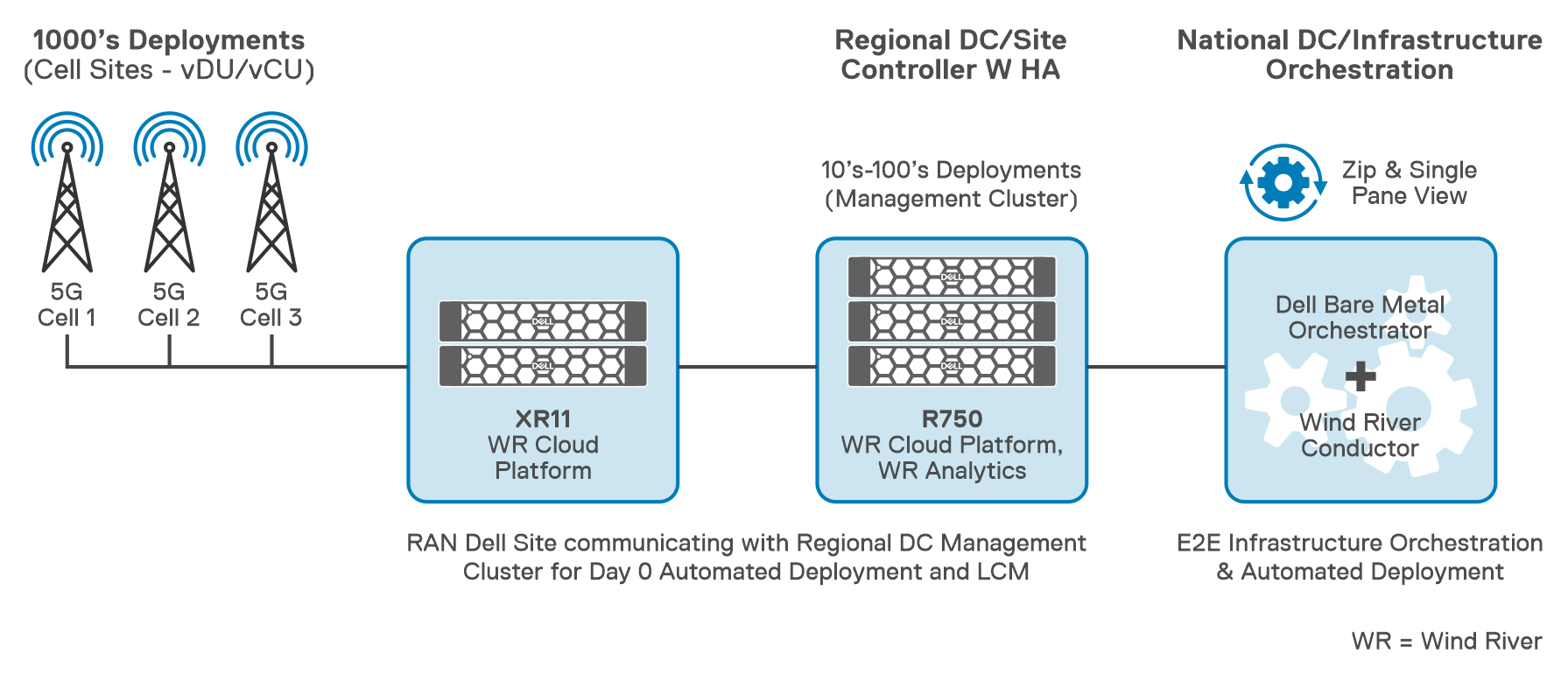
Key Advantages:
- Reduces the complexity of integration and lifecycle management in a highly distributed, disaggregated network, allowing lower operating costs while reducing time to deploy new services while accelerating innovation.
- Dell's comprehensive, factory-integrated solution simplifies supply chain management by reducing the number of components and suppliers needed to build out the network. In addition, to back-haul optimization by preloading all software needed for day-0 and day-1 automation.
- It has been thoroughly tested and includes design guidance for building and scaling out a network that provides low latency, redundancy, and High Availability (HA) for carrier-grade RAN Applications.
- Simplified support with Dell providing single contact support for the whole stack including all hardware and software from Dell and Wind River with an option for carrier-grade support.
- Reduces the total cost of ownership (TCO) for CSPs by deploying a fully integrated, validated, and production-ready vRAN/O-RAN cloud infrastructure solution with a smaller footprint, low latency, and operational simplicity.
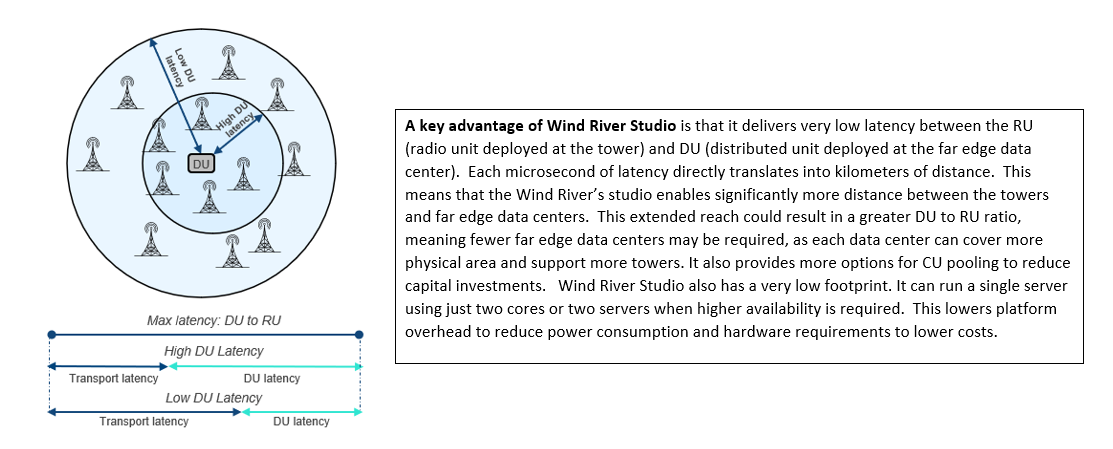

Wind River Studio Cloud Platform Architecture
Wind River Studio Cloud Platform Distributed Cloud configuration supports an edge computing solution by providing central management and orchestration for a geographically distributed network of cloud platform systems with easy installation with support for complete Zero Touch Provisioning of the entire cloud, from the Central Region to all the Sub-Clouds
The architecture features a synchronized distributed control plane for reduced latency, with an autonomous control plane such that all sub-cloud local services are operational even during loss of Northbound connectivity to the Central Region (Distributed cloud system controllers cluster location) which is quite important because Studio Cloud Platform can scale horizontal or vertical independent from the main cloud in the regional data center (RDC) or in National Data center (NDC).
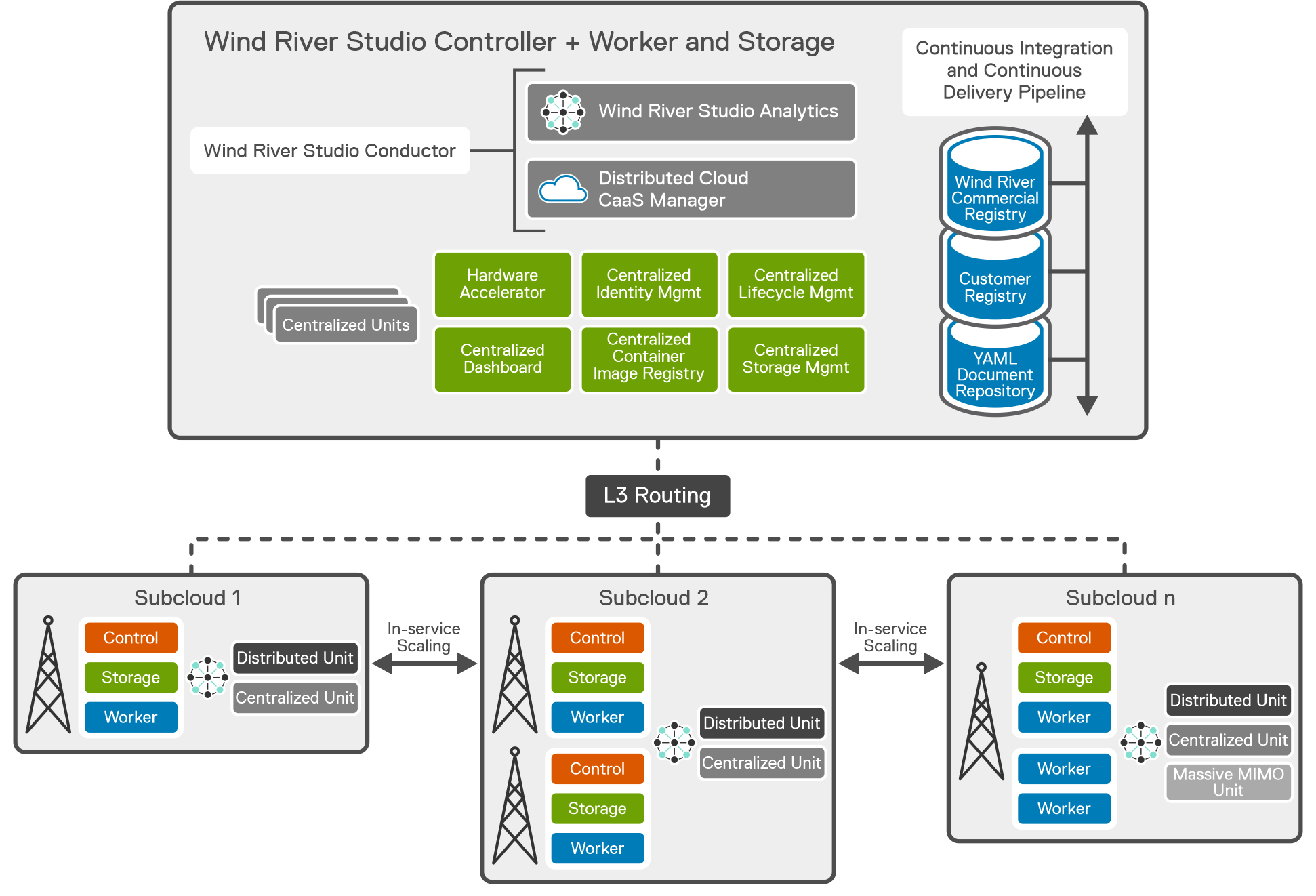
Cell Sites, or sub-clouds, are geographically dispersed edge sites of varying sizes. Dell Telecom Infrastructure Blocks for Wind River cell site installations can be either All-in-One Simplex (AIO- SX), AIO Duplex (DX), or All-in-One (AIO) DX + workers. For a typical AIO SX deployment, at least one server is needed in a sub-cloud. Remote worker sites running Bare Metal Orchestrator are where sub-clouds are set up.
- AIO-SX (All-In-One Simplex) - A complete hyper-converged cloud with no HA, with ultra-low cloud platform overhead of 2 physical cores and 64G Memory, and 500G Disk, which is required to run the cloud, while the rest of the CPU cores, memory, and disk are used for the applications.
- AIO-DX (All-In-One Duplex) - Same as AIO-SX except that it runs on 2 servers to provide High Availability (HA) up to 6-9's.
- AIO-DX (All-In-One Duplex) +Workers - Two nodes plus a set of worker nodes (starting small and growing as workload demands increase)

The Central Site at the RDC is deployed as a standard cluster across three Dell PowerEdge R750 servers, two of which are the controller nodes and one of which is a worker node, The Central Site also known as the system controller, provides orchestration and synchronization services for up to 1000 distributed sub-clouds, or cell sites. Controller-0, Controller-1, and Workers-0 through n are the various controllers in the system. To implement AIO DX, both Controller-0 and Controller-1 are required.
Wind River Studio Conductor runs in the National Data Center (NDC) as an orchestrator and infrastructure automation manager. It integrates with Dell's Bare Metal Orchestrator (BMO) to provide complete end-to-end automation for the full hardware and software stack. Additionally, it provides a centralized point of control for managing and automating application deployment in an environment that is large-scale and distributed.
Studio Conductor receives information from Bare Metal Orchestrator as new cell sites come online. Studio Conductor instructs the system controller (CaaS manager) to install, bootstrap, and deploy Studio Cloud Platform at the cell sites. It supports TOSCA (Topology and Orchestration Specification for Cloud Application) based blueprint modeling. (Blueprints are policies that enable orchestration modeling.) Studio Conductor uses blueprints to map services to all distributed clouds and determine the right place to deploy. It also includes built-in secret storage to securely store password keys internally, reducing threat opportunities.
Studio Conductor can adapt and integrate with existing orchestration solutions. The plug-in architecture allows it to accommodate new and old technologies, so it can easily be extended to accommodate evolving requirements.
Wind River Studio Analytics is an integrated data collection, monitoring, analysis, and reporting tool used to optimize distributed network operations. Studio Analytics specifically solves a unique use case for the distributed edge. It provides visibility and operational insights into the Studio Cloud Platform from a Kubernetes and application workload perspective. Studio Analytics has a built-in alerting system with the ability to integrate with several third-party monitoring systems. Studio Analytics uses technology from Elastic. co as a foundation to take data reliably and securely from any source and format, then search, analyze, and visualize it in real time. Studio Analytics also uses the Kibana product from Elastic as an open user interface to visually display the data in a dashboard.
Dell Telecom Multi-Cloud Foundation Infrastructure Blocks provides a validated, automated, and factory integrated engineered system that paves the way for the zero-touch deployment of 5G Telco Cloud Infrastructure, to operation and management of the lifecycle of vRAN and Open RAN sites, all of which contribute to a high-performing network that lessens the cost, time, complexity, and risk of deploying and maintaining a telco cloud for the delivery of 5G services.
To learn more about our solution, please visit the Dell Telecom Multi-Cloud Foundation solutions site
Authored by:
Gaurav Gangwal
Senior Principal Engineer – Technical Marketing, Product Management
About the author:
Gaurav Gangwal works in Dell's Telecom Systems Business (TSB) as a Technical Marketing Engineer on the Product Management team. He is currently focused on 5G products and solutions for RAN, Edge, and Core. Prior to joining Dell in July 2022, he worked for AT&T for over ten years and previously with Viavi, Alcatel-Lucent, and Nokia. Gaurav has an engineering degree in electronics and telecommunications and has worked in the telecommunications industry for about 14 years. He currently resides in Bangalore, India.


Simplifying 5G Network Deployment with Dell Telecom Infrastructure Blocks for Red Hat
Fri, 19 Jan 2024 15:08:05 -0000
|Read Time: 0 minutes


Welcome back to our 5G Core blog series. In the second blog post of the series, we discussed the 5G Core, its architecture, and how it stands apart from its predecessors, the role of cloud-native architectures, the concept of network slicing, and how these elements come together to define the 5G Network Architecture.
In this third blog, we look at Dell Technologies’ and Red Hat's collaboration with their latest offering of Dell Telecom Infrastructure Blocks for Red Hat. We explore how Infrastructure Blocks streamline Communications Service Providers’ (CSPs) processes for a Telco cloud used with 5G core from initial technology onboarding at day 0/1 to day 2 life cycle management.
Helping CSPs transition to a cloud-native 5G core
Building a cloud-native 5G core network is not easy. It requires careful planning, implementation, and expertise in cloud-native architectures. The network needs to be designed and deployed in a way that ensures high availability, resiliency, low latency, efficient resource utilization, and flawless component interoperability. CSPs may feel overwhelmed when considering the transition from legacy architectures to an open, best-of-breed cloud-native architecture. This can lead to delays in design, deployment, and life cycle management processes that stall projects and reduce a CSP’s ability to effectively deploy and manage their disaggregated cloud-native network.
Automation plays a critical role in managing deployment and life cycle management processes. Many projects stall or fail due to poorly defined automation strategies that make it difficult to ensure compatibility between hardware and software configurations across a large, distributed network. This is especially true when trying to deploy and manage a cloud platform running on bare metal.
Dell Telecom Infrastructure Blocks for Red Hat are foundational building blocks for creating a Telco cloud that is based on Red Hat OpenShift. They aim to reduce the time, cost, and risk of designing, deploying, and maintaining 5G networks using open software and industry standard infrastructure. The current release of Telecom Infrastructure Blocks for Red Hat supports the creation of management and workload clusters for 5G core network functions running Red Hat OpenShift on bare metal servers.
There are a number of challenges to build and maintain Kubernetes clusters on bare metal to run 5G network functions:
- Ensuring interoperability and fault tolerance in a disaggregated network is not an easy task. Deploying and managing Kubernetes clusters on bare metal requires extensive design, planning, and interoperability testing to ensure a reliable, fault tolerant, and performant system.
- Automating the deployment and life cycle management of hardware resources and cloud software in a bare metal environment can be complex. It involves deploying and updating a fleet of bare metal servers at scale.
- There is a lack of pre-built software integrations specifically designed for deploying Kubernetes clusters on bare metal servers and bringing those cluster configurations to a state where they are ready to run workloads. This means that configuring and deploying Kubernetes on bare metal frequently requires more manual effort to build and maintain the automation needed to manage deployments and upgrades at scale. This manual effort can be time-consuming and add complexity that introduces risk to the process.
- This lack of consistent, easy-to-manage automation to deploy and update the cloud stack to meet workload requirements also make it harder to implement a unified cloud platform across all workloads. This leads to infrastructure silos that limit the ability to pool resources to improve infrastructure utilization rates, which in turn reduces network TCO efficiency.
These challenges are amplified when running 5G network functions, which require low latency and high reliability to meet carrier-grade service level agreement (SLAs). This collaboration between Dell and Red Hat aims to offer a comprehensive solution for CSPs that addresses the challenges associated with building and maintaining carrier-grade cloud infrastructure for 5G core network functions.
Key objectives of Dell Telecom Infrastructure Blocks for Red Hat
Implement a “shift left” approach
In software development, the term “shift left” refers to the ability to move tasks to an earlier stage in the development or production process to reduce time to value for those processes. The shift left approach being offered with Infrastructure Blocks moves much of the testing and integration work performed by the CSP into the supply chain prior to onboarding the new technology. This method provides CSPs with a speedy path to value by shortening the preparation and validation phase for a new network deployment. It also simplifies the procurement process by reducing the number of suppliers the CSP needs to work with and simplifies support by providing one call support for the full cloud stack. Proactive problem-solving, reduction of field touch points, risk minimization, and operational simplification are byproducts of the Infrastructure Block approach that hasten the introduction of new technology into a CSP’s network. By adopting this approach, CSPs can obtain faster rollout times and reduced operational costs. Dell does three things to help CSPs shift the technology onboarding processes left:
Engineering
Telecom Infrastructure Blocks are foundational building blocks that are co-designed with Red Hat to help CSPs build and scale out their network. These building blocks are purpose-built to meet specific workload requirements. Dell collaborates with Red Hat to maintain a roadmap of feature enhancements and perform continuous design and integration testing to accelerate the adoption of new technologies and software upgrades. The design planning and extensive interoperability testing performed by Dell simplifies the processes of building and maintaining a fault tolerant and performant cloud platform to run 5G core workloads.
Automation
Many CSPs today rely on procedural automation that they build and maintain on their own to automate the deployment and life cycle management of their cloud platform at scale. Procedural automation requires an understanding of the current state of their cloud stack and the maintenance of scripts or playbooks to define the steps needed to update the configuration to the desired state. When deploying Kubernetes on bare metal to support 5G core workloads, there are a number of items with dependencies that must be configured appropriately, including the following properties:
- Cloud platform software version
- BIOS version and settings
- Firmware versions for network interface cards (NICs) and other Peripheral Component Interconnect Express (PCIe) cards
- Single root I/O virtualization (SR-IOV) / Data Plane Development Kit (DPDK) configurations
- RAID configurations
- Site-specific data
Building and maintaining these scripts and automation playbooks is no easy task. It requires an up-to-date view of the current configuration of the infrastructure, an understanding of the dependencies between hardware and software that must be met to perform an update, and people with specialized skills that include knowledge of server hardware and the tools to manage them, the cloud software, and how to write or update playbooks to execute deployments and upgrades.
Managing this across a large, distributed network with a range of workloads that frequently require unique configurations of the cloud stack is a difficult and time-consuming process. Also consider that, in an open ecosystem environment, there is always a new version of software, BIOS, or firmware coming and the people with the needed skill sets are in short supply, resulting in a herculean effort with mixed results.
Telecom Infrastructure Blocks include purpose-built automation software that is easy to use and maintain. The blocks integrate with Red Hat Advanced Cluster Management and Red Hat OpenShift to automate deployment and life cycle management of the hardware and software stack used in a Telco cloud. This software uses declarative automation to simplify the deployment and upgrade of the cloud platform hardware and software to align with approved configuration profiles. With declarative automation, the CSP simply defines the desired state of the cloud stack, and the automation software determines the steps required to achieve the desired state and executes those steps to align the system with the approved configuration.
This infrastructure automation software uses a declarative data model that defines the desired state of the system, the resources properties, and keeps a list of the current state of the cloud configuration and inventory, which significantly simplifies the deployment and life cycle management of the cloud stack. Infrastructure Blocks come with Topology and Orchestration Specification for Cloud Applications (TOSCA) workflows that define the configurations needed to update the system based on the extensive design and validation testing performed by Dell and Red Hat. Dell provides regular updates that simplify the process of upgrading to the latest release. CSPs simply update a Customer Input Questionnaire and the automation software updates the hardware and the cloud platform software, and brings them to a workload-ready state with a single click of a button.
Integration
Dell ships fully integrated systems that are designed, optimized, and tested to meet the requirements of a range of telecom use cases and workloads. They include all the hardware, software, and licenses needed to build and scale out a Telco cloud. Delivering fully integrated building blocks from Dell’s factory significantly reduces the time spent configuring infrastructure onsite or in a network configuration center. They are also backed by Dell Technologies one-call support for the full cloud stack that meets telecom SLAs. Dell has established escalation paths with Red Hat to ensure the highest levels of support for customers.
Streamlining Day 0 through Day 2 tasks with Telecom Infrastructure Blocks
In a typical CSP network operating model, there are four stages an CSPs goes through from initial technology onboarding through managing ongoing operations. These stages are:
- Stage 1: Technology onboarding (Day 0)
- Stage 2: Pre-production (Day 0)
- Stage 3: Production (Day 1)
- Stage 4: Operations and lifecycle management (Day 2+)
Dell Telecom Infrastructure Blocks were built to streamline each stage of the processes to reduce the time and risk of building and maintaining a Telco cloud. We do this by proactively working with Red Hat to create an engineered system that meets telecom SLAs, includes automation that delivers zero-touch provisioning, and simplifies life cycle management through continuous design and integration testing.
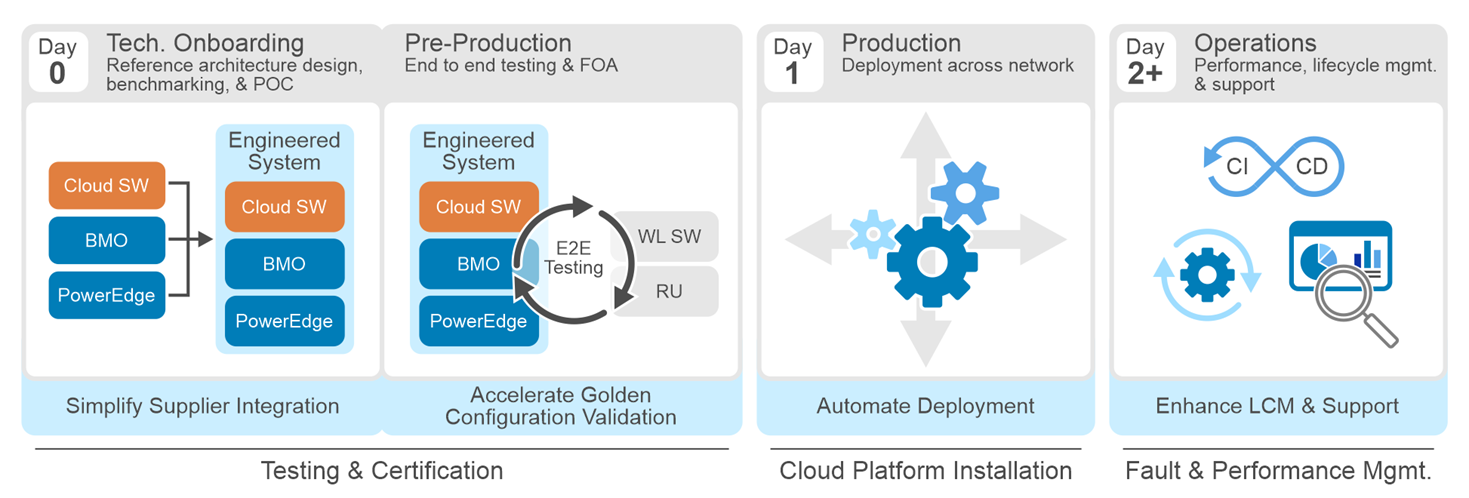
Let's look at how Dell Telecom Infrastructure blocks affects CSP processes from Day 0 to Day 2+.
Stage 1: Day 0 technology onboarding
Dell and Red Hat collaborate to design an engineered system that is validated through an extensive array of test cases to ensure its reliability and performance. These test cases cover aspects such as functionality, interoperability, security, reliability, scalability, and infrastructure-specific requirements for 5G Core workloads. This testing is aimed at ensuring optimal performance across a diverse array of performance metrics and scale points, thereby guaranteeing performant system operation.
Some of our design and validation test cases include:
Cloud Infrastructure Cluster testing: Cloud Infrastructure Cluster testing refers to the process of testing the infrastructure components of a cloud cluster to ensure their proper functioning, performance, and scalability. It involves validating the networking, storage, compute resources, and other infrastructure elements within a cluster. These test cases include:
- Installation and validation of Infrastructure Block plugins and automation.
- Cluster storage (Red Hat OpenShift AI) validation and testing.
- Validation of cluster network configurations
- Verification of Container Network Interface (CNI) plugin configurations in the cluster.
- Validation of high availability configurations
- Scalability and performance testing
Performance Benchmarking testing: Performance Benchmarking testing usually includes several steps. First, test scenarios are created to simulate real-world usage. Second, performance tests are conducted and the resulting performance data is collected and analyzed. Finally, the results are compared to established benchmarks. Some of the testing performed with Infrastructure Blocks includes:
- CPU benchmarking
- Memory benchmarking
- Storage benchmarking
- Network benchmarking
- Container as a Service (CaaS) benchmarking
- Interoperability tests between the Infrastructure and CaaS layers
At this step, we define the automation workflows and configuration templates that will be used by the automation software during the deployment. Dell works proactively with its customers and partners to understand their best practices and incorporate those into the blueprints included with every Telecom Infrastructure Block.
This process produces an engineered system that streamlines the CSP’s reference architecture design, benchmarking, and proof of concept (POC) processes to reduce engineering costs and accelerate the onboarding of new technology. To further streamline the design, validation, and certification process, we provide Dell Open Telecom Ecosystem Lab (OTEL), which can act as an extension of a CSP’s lab to validate workloads on Infrastructure Blocks that meet the CSP’s defined requirements.
Stage 2: Pre-production
The main objective in stage 2 is to onboard network functions onto the cloud infrastructure, define the network golden configuration, and to prepare it for production deployment. Infrastructure Blocks eliminates some of the touch steps in the onboarding by:
- Delivering an integrated and validated building block direct from Dell’s factory
- Delivering a deployment guide that simplifies onboarding
- Providing Customer Input Questionnaires that are configuration input templates used by the automation software to streamline deployment
CSPs can also leverage the Red Hat test line in Dell’s Open Telecom Ecosystem Lab (OTEL) to validate and certify the CSP’s workloads on Infrastructure Blocks. OTEL can play a significant role in enabling CSPs and partners by developing custom blueprints or performing custom tests required by the CSP using Dell’s Solution Integration Platform (SIP) which is part of OTEL. SIP is an advanced automation and service integration platform developed by Dell. It supports multi-vendor system integration and life cycle management testing at scale. It uses industry standard components, toolkits, and solutions such as GitOps.
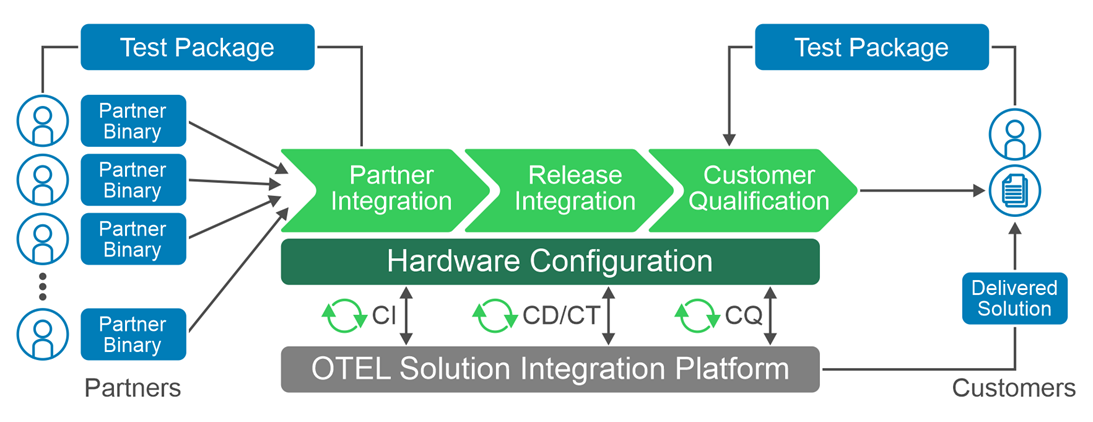 Dell Services also offers tailor-made configurations to cater to specific operator needs. These are carried out at a Dell second-touch configuration facility. Here, configurations customized to the customer's specifications are pre-installed and then dispatched directly to the customer's location or configuration facility.
Dell Services also offers tailor-made configurations to cater to specific operator needs. These are carried out at a Dell second-touch configuration facility. Here, configurations customized to the customer's specifications are pre-installed and then dispatched directly to the customer's location or configuration facility.
Stage 3: Production
At the production stage, Dell integrates and configures all hardware and settings to support the discovery and installation of the validated version of the cloud platform software, which eliminates the need to configure hardware on site or in a configuration center. Dell’s infrastructure automation software then deploys the validated versions of Red Hat Advanced Cluster Manager and Red Hat Openshift on the servers used in the management and workload clusters and brings those clusters to a workload ready state. This process ensures a consistent and reliable installation process that reduces the risk of configuration errors or compatibility issues. Dell's automation enables zero-touch provisioning that configures hundreds of servers at the same time with full visibility into the health and status of the server infrastructure before and after deployment. Should the CSP need assistance with deployment, Dell's professional services team is standing by to assist. Dell ProDeploy for Telecom provides on-site support to rack, stack, and integrate servers into their network or remote support for deployment.
Stage 4: Operations and lifecycle management
In Day 2+ operations, CSPs must sustain network performance while adapting to changes to the network over time. This includes ensuring software and infrastructure compatibility as updates are made to the network, performing rolling updates, fault and performance management, scaling resources to meet network demands, ensuring efficient use of network resources, and adapting to technology evolution.
Infrastructure Blocks simplify Day 2+ operations in several ways:
- Dell works with Red Hat, its customers, and other partners to capture updates and new requirements necessary to evolve Infrastructure Blocks to support new technologies and software enhancements over time. This requires pro-active collaboration to ensure continuous roadmap alignment across parties. Dell then performs extensive design and validation testing on these enhancements before integrating them into Infrastructure Blocks to deliver a resilient and performant design. This helps CSPs stay on the leading edge of the technology curve while minimizing the risk of encountering faults and performance issues in production.
- Today, Telecom Infrastructure Blocks offers support for three releases per year. In every release, we prioritize the introduction of new capabilities, features, components, and solution enhancements. In addition, there are six patch releases per year that prioritize sub features to ensure compatibility across different releases. Long Term Support releases are provided at the end of the twelve-month release cycle, with a focus on fixing any solution defects that may arise.
- The out-of-the box automation provided with Infrastructure Blocks ensures a consistent, carrier-grade deployment or upgrade of the hardware and cloud platform software each time. This eliminates configuration errors to further reduce issues found in production.
- When bringing together various hardware and software components, CSPs frequently manage different release cycles to support a range of workload requirements. To address any difficulties with software compatibility and life cycle management, Dell Technologies has created a system release cadence process. It includes testing, validating, and locking the release compatibility matrixes for all Infrastructure Block components. This helps to resolve deployment problems affecting software compatibility and Day 2+ life cycle management procedures.
- Dell Professional Services can also provide custom integrations into a CSP’s CI/CD pipeline, providing the CSP with validated updates to the cloud infrastructure that pass directly into the CSP’s CI/CD tool chains to enhance DevOps processes.
- In addition, Dell offers single-call, carrier grade support that meets telecom grade SLAs with guaranteed response and service restoration times for the entire cloud stack (hardware & software).
- The declarative automation provided with Infrastructure Blocks eliminates the time spent updating scripts and playbooks to push out system updates and minimizes the risk of configuration errors that lead to fault or performance issues.
Summary
Dell Telecom Infrastructure Blocks for Red Hat offers a streamlined and efficient way to build and manage Telco cloud infrastructure. From initial technology onboarding to Day 2+ operations, they simplify every step of the process. This makes it easier for CSPs to transition from their vertically integrated, legacy architectures of today to an open cloud-native software platform running on industry standard hardware that delivers reliable and high-quality services to their customers.
This blog post is a collaborative effort from the staff of Dell Technologies and Red Hat.







